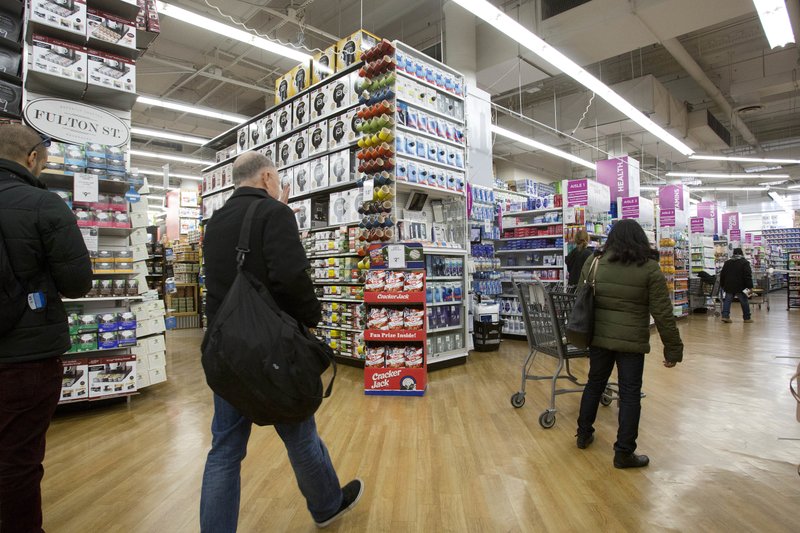WASHINGTON -- Online shopping is reaching such a critical mass with American households that many of the icons of the traditional mall -- from Macy's to The Gap and J.C. Penney -- face an increasingly uncertain future.
A government report Friday suggested a modestly healthy consumer, with retail sales up 1.3 percent in April.
"This is all part and parcel of the consumption numbers coming more in line with the income numbers we've been seeing," said Jacob Oubina, senior U.S. economist at RBC Capital Markets LLC in New York. "The breadth of this report was extremely constructive."
Americans are eating out more at restaurants. They're buying more cars. But the main beneficiaries of spending in the past year have been Amazon, eBay and other Internet behemoths.
Spending at these nonstore retailers shot up 10.7 percent from a year ago, the government said in a week when earnings reports showed disturbing drop-offs at Macy's, Kohl's, Nordstrom and J.C. Penney.
Shoppers who once crowded malls are now ordering on phones, computers and tablets, siphoning sales from physical stores, which face growing pressure to reinvent their businesses.
"Online is cannibalizing the store business," said Marshal Cohen, chief industry analyst at the NPD Group.
The magnitude of the change may be just beginning to intensify. Online shopping has attuned customers to focusing on price and hunting for the best bargains, thereby shrinking profit margins at many stores.
Retailers have responded by closing stores to cut costs, leaving more shopping malls and plazas empty. The result has been a painful upheaval in an industry that employs 15.9 million people.
Online retailers, in the meantime, have been catching up to general merchandise stores, Wal-Mart to Nieman Marcus.
Back in 2000, for every dollar spent at stores, just 30 cents were spent online and at mail-order houses, according to government figures. Now, the online category makes up nearly 70 cents for every dollar spent at general merchandise stores.
"We have yet to learn the ramifications of just how paramount these shifts in consumer behavior are," Cohen said. "This is a cultural shift from the younger generation that is only going to carry forward."
The April retail sales report from the Commerce Department showed uniformly solid growth. It assuaged concerns that an economic slowdown in the first three months of 2016 might have significantly disrupted consumer spending.
The gains weren't just online. Though Internet purchases rose 2.1 percent from March, auto sales jumped 3.2 percent. Clothiers, restaurants, sporting goods stores, grocers and gas stations also posted gains.
Only building materials stores suffered a monthly drop, but their annual sales growth was solid.
Though sales at department stores edged up slightly, they've sunk 1.7 percent over the past 12 months.
Prices charged by U.S. manufacturers, farmers and other producers rose for the first time since January, lifted by higher costs for gas, steel and medicines, the Labor Department said Friday.
The producer price index, which measures price changes before they reach the consumer, increased 0.2 percent in April. That followed small declines in February and March.
Producer prices were unchanged from a year ago. That suggests inflation at the consumer level is likely to remain low.
Excluding the volatile food and energy categories, producer prices ticked up 0.1 percent last month and 0.9 percent from a year ago.
The figures suggest that overall inflation remains tame. Sluggish economic growth, modest wage increases, and sharp competition among retailers have kept inflation low since the recession ended in 2009.
Wholesale gasoline prices jumped 5.5 percent in April, while food costs slipped 0.3 percent. The cost of some types of steel jumped 22.1 percent, while pharmaceutical prices rose 1 percent.
Many Americans feel squeezed by rising costs for more expensive items such as health care and a college education, but those categories make up a relatively small part of the government's inflation measures.
Rising rents and home prices have made housing less affordable, but the government has struggled to accurately measure those costs.
Consumers are seeing few price increases for most goods and services. In the past year, consumer prices have increased just 0.9 percent. Excluding the volatile food and energy categories, they are up 2.2 percent.
U.S. businesses in March posted the biggest increases in inventories and sales since June, the Commerce Department said Friday.
Business inventories rose 0.4 percent from February. Sales rose 0.3 percent.
The March increases ended months of falling sales and inventories.
Falling inventories have been a big drag on the U.S. economy. They trimmed economic growth by 0.3 percentage point from January through March, reducing the first-quarter increase to a lackluster 0.5 percent annual rate. Inventories have pulled economic growth lower for three straight quarters. The March inventory increase could reduce the drag on growth and lead to somewhat better numbers when the government revises the first-quarter numbers.
Manufacturers and wholesalers reported higher sales and bigger inventories in March. Retailers increased inventories by 1 percent but saw sales slip 0.3 percent.
Inventories of autos and auto parts rose 2.3 percent in March, most since October 2013. The increased stockpiles reflect strong auto sales. Americans bought just over 1.5 million cars and trucks last month, giving the auto industry its best April ever.
Information for this article was contributed by Josh Boak, Anne D'Innocenzio, Christopher S. Rugaber and Paul Wiseman of The Associated Press and Michelle JAmrisko and Shobhana Chandra of Bloomberg News.
Business on 05/14/2016

